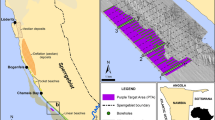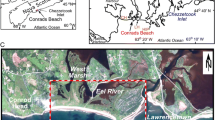Abstract
The Kachelotplate is an ephemeral sand bank island which frequently appeared and disappeared since the first recorded in nautical charts of the 17th century. Within the stability field of barrier islands it represents the sole occurrence of an ephemeral sand body showing formation of initial aeolian dunes with vegetation cover. Due to its exposed position the Kachelotplate complex is strongly affected by high hydrodynamic impact of storm surges occurring several times a year. This results in sedimentary dynamics preventing the development of a stable, storm-resistant dune belt which would be necessary for the evolution of a barrier island. Nevertheless, most of the sedimentary/structural units of the Kachelotplate are known as typical elements of the adjacent barrier islands. These findings suggest that this ephemeral sand bank island may reflect the ‘missing link’ in the well-establishedBarckhausen model of barrier island evolution.
Similar content being viewed by others
References
Barckhausen, J. (1969): Entstehung und Entwicklung der Insel Langeoog. Beitrag zur Quartärgeologie und -paläogeographie eines ostfriesischen Küstenabschnittes. — Oldenburger Jahrb.,68: 239–281.
Brandt, G., Wehrmann, A. &Wirtz, K.W. (2008): Rapid invasion ofCrassostrea gigas into the German Wadden Sea dominated by larval supply. — Journal of Sea Research,59 (4): 279–296
Davis, J.L. (1964): A morphogenic approach to world shorelines. — Zt. Geomorph.,8: 27–42.
Dörjes, J. (1978): Das Watt als Lebensraum. — In:Reineck, H.-E. [Ed.]: Das Watt — Ablagerungs- und Lebensraum. — 107–143; Frankfurt a. M. (Kramer).
Femming, B.W. (1989): Jahresbericht 1988 der Sektion Meeresgeologie I. — Ber. Senckenberg am Meer,89/1: 3–25.
Femming, B.W. (1991): Zur holozänen Entwicklung, Morphologie und faziellen Gliederung der Ostfriesischen Insel Spiekeroog (Südliche Nordsee). — Ber. Senckenberg am Meer,91/3: 1–51.
Flemming, B.W. &Davis, R.A. (1994): Holocene evolution, morphodynamics and sedimentology of the Spiekeroog Barrier Island system (southern North Sea). — Senckenbergiana maritima,24: 117–155.
Gerdes, G. &Wehrmann, A. (2008): Biofilms in surface sediments of the ephemeral sand bank island Kachelotplate (southern North Sea). — Senckenbergiana maritima,38 (2): 173–183.
Gripp, K. (1944): Entstehung und künftige Entwicklung der Deutschen Bucht. — Arch. Dt. Seewarte u. Marine Observat.,63: 1–45; Hamburg.
Guza, R.T. &Inman, D.L. (1975): Edge waves and beach cusps. — J. geophys. Res.,80: 2997–3012.
Hanisch, J. (1980): Neue Meeresspiegeldaten aus dem Raum Wangerooge. — Eiszeitalter u. Gegenwart,30: 221–228.
Hayes, M.O. (1979): Barrier island morphology as a function of tidal and wave regime. — In:Leatherman, S.P. [Ed.]: Barrier Islands: 1–27; New York (Academic Press).
Hertweck, G. (1995): Verteilung charakteristischer Sedimentkörper und Benthossiedlungen im Rückseitenwatt der Insel Spiekeroog, südliche Nordsee. I. Ergebnisse der Wattkartierung 1988–92. — Senckenbergiana maritima,26 (1/2): 81–94, 1 Taf.; Frankfurt a. M.
Homeier, H. &Luck, G. (1969): Das Historische Kartenwerk 1:50 000 der Niedersächsischen Wasserwirtschaftsverwaltung als Ergebnis historisch-topographischer Untersuchungen und Grundlage zur kausalen Deutung der Hydrovorgänge im Küstengebiet. — Veröffentl. Nieders. Inst. für Landeskde., Landesentwicklung Univ. Göttingen, Reihe A: Forsch. Landes- u. Volkskde. I. Natur, Wirtschaft, Siedlung u. Planung,93: 36 pp. + Anh. 28 pp.; Göttingen-Hannover (Wurm).
Klaassen, K. Bormann, H., Klenke, T. &Liebezeit, G. (2008): The impact of hydrodynamics and texture on the infiltration of rain and marine waters into sand bank island sediments — Aspects of infiltration and groundwater dynamics. — Senckenbergiana maritima,38 (2): 163–171.
Lüders, K. (1953): Die Entstehung der ostfriesischen Inseln und der Einfluß der Dünenbildung auf den geologischen Aufbau der ostfriesischen Küste. — Probl. Küstenforsch.,5: 5–15.
Niedringhaus, R. &Lieckweg, T. (2008): First stages of arthropod colonisation of a sand bank island in the German Wadden Sea. — Senckenbergiana maritima,38 (2): 123–135.
Penck, A. (1894): Morphologie der Erdoberfläche. — Bibliothek der geographischen Handbücher: 696 pp.; Stuttgart (Engelhorn).
Pott, R. (1995): Farbatlas Nordseeküste und Nordseeinseln — Ausgewählte Beispiele aus der südlichen Nordsee in geobotanischer Sicht. — 288 pp.; Stuttgart (Ulmer).
Reineck, H.-E (1960): Über den Transport des Riffsandes. — Jber. Forschungsstelle Norderney 1959,11: 21–38, 6 Anl.
Schmidt, A.,Wehrmann, A. &Dittmann, S. (2008): Population dynamics of the invasive Pacific oysterCrassostrea gigas during the early stages of an outbreak in the Wadden Sea (Germany). — Helgoland Marine Research, DOI10.1007/s10.1007/s10152-008-0125-8
Short, A.D. (1979): A three-dimensional beach stage model. — J. Geol.,87: 553–571.
Sindowski, K.-H. (1970): Geologische Karte von Niedersachsen 1:25.000. — Erl. Bl. Spiekeroog Nr. 2212: 56 pp.; Hannover.
Sindowski, K.-H. (1973): Das ostfriesische Küstengebiet — Insel, Watten und Marschen. Samml. Geol. Führer,57: 162 pp.; Berlin, Stuttgart (Borntraeger).
Streif, H. (1990): Das ostfriesische Küstengebiet. Nordsee, Inseln, Watten und Marschen. — Samml. geol. Führer,57: 376 pp.; Berlin (Borntraeger).
Wehrmann, A., Herlyn, M., Bungenstock, F., Hertweck, G. &Millat, G. (2000): The distribution gap is closed — first record of naturally settled Pacific oystersCrassostrea gigas in the East Frisian Wadden Sea, North Sea. — Senckenbergiana maritima,30 (3/6): 153–160.
Weisensee, M., Smit-Philipp, H., Tast, J., Nebel, K. &Marczak, D. (2008): On the Acquisition of Geometric and Semantic Data of the Kachelotplate by means of Airborne and Terrestrial LIDAR. — Senckenbergiana maritima,38 (2): 123–129.
Wright, L.D. &Chappell, J. &Thom, B.C. &Bradshaw, M.P. &Cowell, P. (1979): Morphodynamics of reflective and dissipative beach and inshore systems: southeast Australia. — Mar. Geol.,32: 105–140.
Wunderlich, F. (1972): Georgia Coastal region, Sapelo Island, U.S.A. — Sedimentology and Biology. III. Beach dynamics and beach development. Senckenbergiana maritima,4: 47–79.
Author information
Authors and Affiliations
Corresponding author
Rights and permissions
About this article
Cite this article
Wehrmann, A., Tilch, E. Sedimentary dynamics of an ephemeral sand bank island (Kachelotplate, German Wadden Sea): An atlas of sedimentary structures. Senckenbergiana maritima 38, 185–198 (2008). https://doi.org/10.1007/BF03055295
Received:
Accepted:
Issue Date:
DOI: https://doi.org/10.1007/BF03055295




